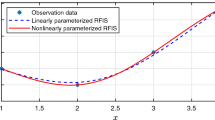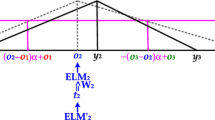Abstract
This paper proposes an automatic and simple approach to design a neo-fuzzy neuron for identification purposes. The proposed approach uses the backfitting algorithm to learn multiple univariate additive models, where each additive model is a zero-order T-S fuzzy system which is a function of one input variable, and there is one additive model for each input variable. The multiple zero-order T-S fuzzy models constitute a neo-fuzzy neuron. The structure of the model used in this paper allows to have results with good interpretability and accuracy. To validate and demonstrate the performance and effectiveness of the proposed approach, it is applied on 10 benchmark data sets and compared with the extreme learning machine (ELM), support vector regression (SVR) algorithms, and two algorithms for design neo-fuzzy neuron systems, an adaptive learning algorithm for a neo-fuzzy neuron systems (ALNFN), and a fuzzy Kolmogorov’s network (FKN). A statistical paired t test analysis is also presented to compare the proposed approach with ELM, SVR, ALNFN, and FKN with the aim to see whether the results of the proposed approach are statistically different from ELM, SVR, ALNFN, and FKN. The results indicate that the proposed approach outperforms ELM and FKN in all data sets and outperforms SVR and ALNFN in almost all data sets that they were statistically different in almost all data sets and that in most data sets the number of fuzzy rules selected by cross-validation was small obtaining a model with a small complexity and good interpretability capability.



Similar content being viewed by others
References
Bodyanskiy Y, Kokshenev I, Kolodyazhniy V (2003) An adaptive learning algorithm for a neo-fuzzy neuron. In: Proceedings of the 3rd conference of the European society for fuzzy logic and technology (EUSFLAT 2003), pp 375–379
Bodyanskiy Y, Tyshchenko O, Kopaliani D (2015) A hybrid cascade neural network with an optimized pool in each cascade. Soft Comput 19(12):3445–3454
Bodyanskiy YV, Tyshchenko OK, Kopaliani DS (2016) Adaptive learning of an evolving cascade neo-fuzzy system in data stream mining tasks. Evolv Syst 7(2):107–116
Box GEP, Jenkins G (1970) Time series analysis, forecasting and control. Holden-Day Inc., San Francisco
Chang CC, Lin CJ (2011) LIBSVM: a library for support vector machines. ACM Trans Intell Syst Technol 2:27:1–27:27. Software available at http://www.csie.ntu.edu.tw/~cjlin/libsvm
Cordón O (2011) A historical review of evolutionary learning methods for Mamdani-type fuzzy rule-based systems: designing interpretable genetic fuzzy systems. Int J Approx Reason 52(6):894–913
de Jesús Rubio J (2016) Least square neural network model of the crude oil blending process. Neural Netw 78:88–96
de Jesús Rubio J (2017) USNFIS: uniform stable neuro fuzzy inference system. Neurocomputing 262:57–66
de Jesús Rubio J (2017) Stable Kalman filter and neural network for the chaotic systems identification. J Frankl Inst 354(16):7444–7462
de Jesús Rubio J, Elias I, Cruz DR, Pacheco J (2017) Uniform stable radial basis function neural network for the prediction in two mechatronic processes. Neurocomputing 227:122–130
Delve repository of University of Toronto. http://www.cs.toronto.edu/~delve/data/datasets.html
Herrera F, Lozano M, Verdegay JL (1995) Tuning fuzzy logic controllers by genetic algorithms. Int J Approx Reason 12(3–4):299–315
Hu Z, Bodyanskiy YV, Tyshchenko OK, Boiko OO (2016) Adaptive forecasting of non-stationary nonlinear time series based on the evolving weighted neuro-neo-fuzzy-ANARX-model. Int J Inf Technol Comput Sci (IJITCS) 8(10):1–10
Hu Z, Bodyanskiy YV, Tyshchenko OK, Boiko OO (2016) An evolving cascade system based on a set of neo-fuzzy nodes. Int J Intell Syst Appl (IJISA) 8(9):1–7
Huang GB, Wang DH, Lan Y (2011) Extreme learning machines: a survey. Int J Mach Learn Cybern 2(2):107–122
Huang GB, Zhu QY, Siew CK (2006) Extreme learning machine: theory and applications. Neurocomputing 70(1–3):489–501
Kolodyazhniy V, Bodyanskiy Y, Otto P (2005) Universal approximator employing neo-fuzzy neurons. In: Reusch B (ed) Computational intelligence, theory and applications, advances in soft computing, vol 33. Springer, Berlin, pp 631–640
Kosko B (1994) Fuzzy systems as universal approximators. IEEE Trans Comput 43(11):1329–1333
Lemos A, Caminhas W, Gomide F (2011) Fuzzy evolving linear regression trees. Evolv Syst 2(1):1–14
Lichman M (2013) UCI machine learning repository. http://archive.ics.uci.edu/ml
Mendes J, Araújo R, Souza F (2013) Adaptive fuzzy identification and predictive control for industrial processes. Expert Syst Appl 40(17):6964–6975
Mendes J, Souza F, Araújo R, Gonçalves N (2012) Genetic fuzzy system for data-driven soft sensors design. Appl Soft Comput 12(10):3237–3245
Miki T, Yamakawa T (1999) Analog implementation of neo-fuzzy neuron and its on-board learning. In: Mastorakis N E (ed) Computational Intelligence and Applications. WSES Press, Piraeus, Greece. pp 144–149
Precup RE, Hellendoorn H (2011) A survey on industrial applications of fuzzy control. Comput Ind 62(3):213–226
Rastegar S, Araújo R, Mendes J (2016) A new approach for online t-s fuzzy identification and model predictive control of nonlinear systems. J Vib Control 22(7):1820–1837
Silva AM, Caminhas W, Lemos A, Gomide F (2014) A fast learning algorithm for evolving neo-fuzzy neuron. Appl Soft Comput 14(Part B):194–209
Sánchez L, Otero J (2004) A fast genetic method for inducting descriptive fuzzy models. Fuzzy Sets Syst 141(1):33–46
Souza FA, Araújo R, Mendes J (2016) Review of soft sensor methods for regression applications. Chemom Intell Lab Syst 152:69–79
Takagi T, Sugeno M (1985) Fuzzy identification of systems and its applications to modeling and control. IEEE Trans Syst Man Cybern 15(1):116–132
Torgo L. Regression datasets. http://www.dcc.fc.up.pt/~ltorgo/Regression/DataSets.html
Uchino E, Yamakawa T (1997) Soft computing based signal prediction, restoration, and filtering. In: Ruan D (ed) Intelligent hybrid systems: fuzzy logic, neural networks, and genetic algorithms. Kluwer Academic Publishers, Boston, pp 331–351
Vapnik VN (1995) The nature of statistical learning theory. Springer, New York
Wang LX (1997) A course in fuzzy systems and control. Prentice-Hall Inc., Upper Saddle River
Wang LX, Mendel J (1992) Fuzzy basis functions, universal approximation, and orthogonal least-squares learning. IEEE Trans Neural Netw 3(5):807–814
Xu S, Wang J (2016) A fast incremental extreme learning machine algorithm for data streams classification. Expert Syst Appl 65:332–344
Yamakawa T, Uchino E, Miki T, Kusanag H (1992) A neo-fuzzy neuron and its applications to system identification and prediction of the system behavior. In: Proceedings of the 2nd international conference on fuzzy logic and neural networks. Iizuka, pp 477–483
Ying H (1997) General Miso Takagi-Sugeno fuzzy systems with simplified linear rule consequent as universal approximators for control and modeling applications. In: IEEE international conference on systems, man, and cybernetics. Computational cybernetics and simulation, vol 2, pp 1335–1340
Acknowledgements
Jérôme Mendes, Francisco Souza, and Saeid Rastegar have been supported by Fundação para a Ciência e a Tecnologia (FCT) under grants SFRH/BPD/99708/2014, SFRH/BPD/112774/2015, and SFRH/BD/89186/2012, respectively.
Author information
Authors and Affiliations
Corresponding author
Ethics declarations
Conflict of interest
We declare that no conflict of interest exits in the submission of this manuscript, and the manuscript is approved by all authors for publication.
Rights and permissions
About this article
Cite this article
Mendes, J., Souza, F., Araújo, R. et al. Neo-fuzzy neuron learning using backfitting algorithm. Neural Comput & Applic 31, 3609–3618 (2019). https://doi.org/10.1007/s00521-017-3301-4
Received:
Accepted:
Published:
Issue Date:
DOI: https://doi.org/10.1007/s00521-017-3301-4




